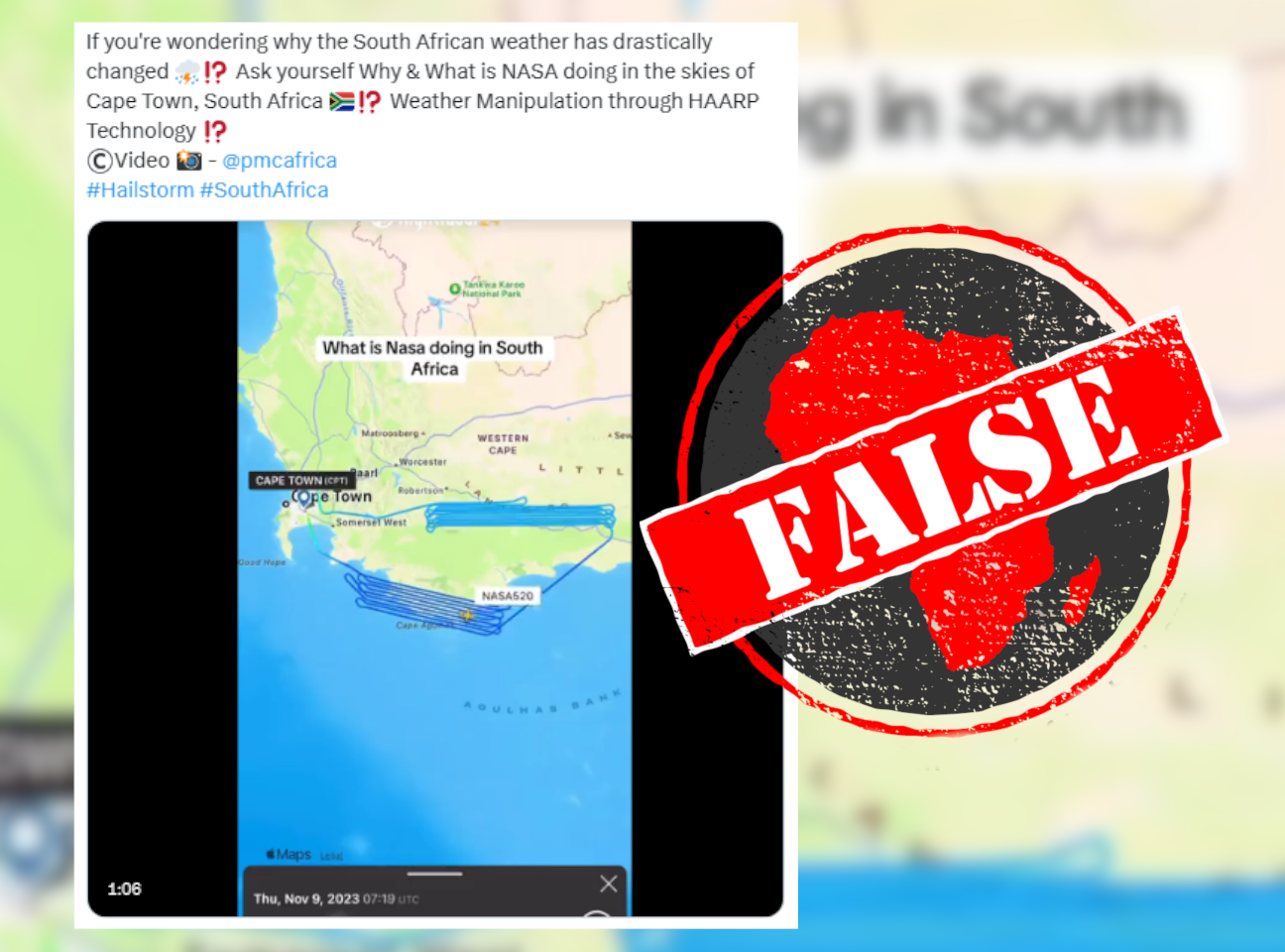IN SHORT: A video tracking a Nasa aircraft flying in strange spirals over South Africa’s Western Cape province has prompted many on social media to claim it’s responsible for recent heavy rain and flooding. But this is not true. The plane is part of a research project to study the Greater Cape Floristic Region.
South Africa has endured extreme weather in 2023. Heatwaves, heavy rain, strong winds and floods have taken lives.
The country’s Western Cape province, for example, has had record-breaking rainfall. At least 11 people died in floods in September. The neighbouring Eastern Cape province was also hit by storm surges.
But could cloud seeding by the US government’s National Aeronautics and Space Administration, or Nasa, be to blame?
That’s a claim doing the rounds on social media.
Most versions of the claim use a video of flight-tracking data from Flightradar24. The video shows an aircraft with the serial number NASA520 flying in a tight spiral pattern over several parts of the Western Cape.
The clip is overlaid with a question: “What is Nasa doing in South Africa?”
One caption to the video, with more than 12,000 views, reads: “If you're wondering why the South African weather has drastically changed!? Ask yourself Why & What is NASA doing in the skies of Cape Town, South Africa!? Weather Manipulation through HAARP Technology!?”
Cape Town is the largest city in the Western Cape and the country’s legislative capital.
Haarp is the High-frequency Active Auroral Research Program, a project of the University of Alaska Fairbanks in the US. Its aim is to study the very top layers of Earth’s atmosphere and their effect on communication and navigation.
The project has nothing to do with cloud-seeding, a way of increasing rain, hail and snowfall by dropping certain substances into clouds. Africa Check has previously debunked a false claim that Haarp technology can “control the weather”.
Another caption to the video claims Nasa is “spraying poisonous chemicals over South Africa”.
But none of this is true. The US space agency’s presence in South Africa is harmless, has been widely publicised, and has had no effect on the weather.

The Biodiversity Survey of the Cape
In October it was announced that the US and South African governments, with the United Nations (UN), would be working together on a project to study the environment of the Western and Eastern Cape provinces.
The project is known as BioSCape, or the Biodiversity Survey of the Cape. It uses data collected by satellites, aircraft and in the field to gain more knowledge about the Greater Cape Floristic Region, one of the greatest biodiversity hotspots on the planet.
The region was inscribed as a world heritage site in 2004 by the UN Educational, Scientific and Cultural Organization, or Unesco. The UN agency describes it as “one of the most special places for plants in the world in terms of diversity, density and number of endemic species”.
BioSCape is funded by Unesco, South Africa’s National Research Foundation, the South African Environmental Observation Network, and by Nasa.
In October and November two modified Gulfstream jets owned by Nasa took to the skies over the Western and Eastern Cape to map plant and animal species on land, in rivers and lakes, and in the coastal seawaters of the floristic region.
One of the jets is a Gulfstream III with the registration number NASA520, as can be seen in the photo on this page of the website DefenceWeb.
The plane was flying in spirals to collect information on the Cape floristic region. It was not seeding clouds, spraying chemicals or doing anything to the weather.
Republish our content for free
For publishers: what to do if your post is rated false
A fact-checker has rated your Facebook or Instagram post as “false”, “altered”, “partly false” or “missing context”. This could have serious consequences. What do you do?
Click on our guide for the steps you should follow.
Publishers guideAfrica Check teams up with Facebook
Africa Check is a partner in Meta's third-party fact-checking programme to help stop the spread of false information on social media.
The content we rate as “false” will be downgraded on Facebook and Instagram. This means fewer people will see it.
You can also help identify false information on Facebook. This guide explains how.


Add new comment